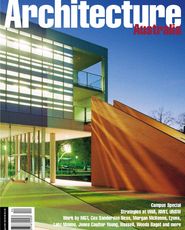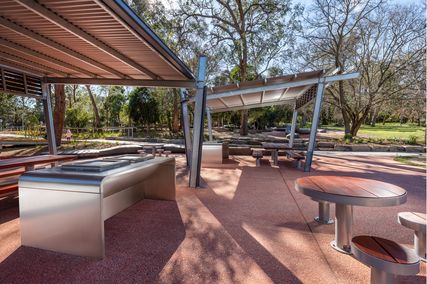Photography by Patrick Bingham-Hall.
Review
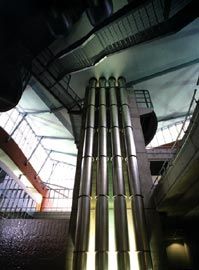
Looking up through the central atrium. The concrete lift shaft is adorned with large stainless steel service ducts.
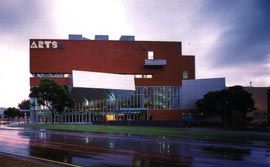
Located on Adelaide’s Light Square, the Roma Mitchell Performing Arts Centre is the latest and addition to the so-called “arts end of town”. It is a successful example of the role institutions can play in urban renewal.
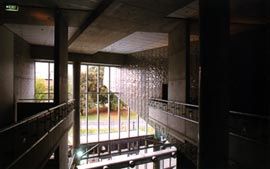
Theatres clad in shining rippled metal sheet cantilever over foyer spaces.
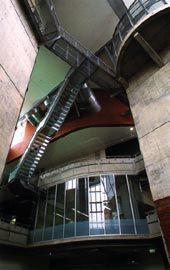
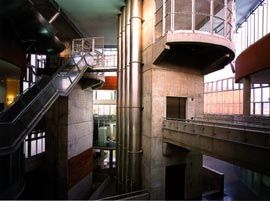
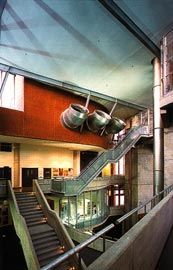

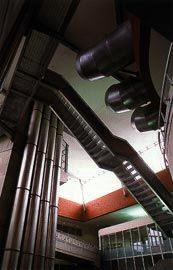
Views of the dramatic central atrium, simulating the chaotics spaces of the city. Stairs, terraces and balconies twist upwards providing complex and ever-changing views.
In modern cities, Plato’s idea of banishing artists is almost achieved through economic means, with many forced to live and work in low-rent premises such as garrets, lofts, and disused warehouses. These spaces, often found in less salubrious districts, are also inhabited by premises trading in nocturnal pleasures, of gambling, drinking, and commercial sex. Here, behind the ordered and civilised face presented through institutions and public spaces, a city reveals itself as a place of chaos and irrationality, of corruption and danger, of dirt and vice. Anticipated by Piranesi in his Carceri, such spaces have provided both the site of production and the subject matter of a great deal of modern art. In fact, time spent among the coarser elements of the city is held by many as a matter of pride, an essential preparation for life as an artist.
Today, with many of the evils of the city harvested for government revenue, institutions are also venturing into less reputable areas, with spaces for art administration and education used to revitalise places guilty of that most unacceptable sin – negative growth. In Adelaide, the strip around Hindley Street, containing many of the city’s late night entertainment venues, has recently been the focus of such attention. Earning the crude sobriquet of the “arts end” of town, it is distinguished from the cultural boulevard of North Terrace, with its art gallery, library, and museum, by having crossed over from the parkland zone into the city grid. On a prominent site in Light Square, Hassell’s Roma Mitchell Arts Centre is the latest, and by far the most impressive, addition to this corner of the city. Named after Australia’s first woman judge and former Governor of South Australia, the building brings together the former Centre for Performing Arts and the North Adelaide School of Art under the Adelaide Institute of TAFE.
Inspired by the industrial materials of the surrounding area, architect Adrian Evans has created a dynamic composition in brick, glass and stainless steel that alludes to British red-brick universities, and, more directly, to Stirling and Gowan’s Leicester University Engineering Building of 1959-63. Unlike the proponents of the “high-tech” style inspired by Stirling’s work, Evans has returned to the Modernist and Constructivist origins of Leicester, celebrating the tension between old and new technologies of masonry and glass. Here, however, the logic is reversed, with the theatres, now clad in shining metal sheet, holding aloft the detached front of the brick box. Beneath the skewed and cantilevered theatres, foyer spaces spill out into the severed corner of the square, making an inviting, if cramped, entry. On the inside, the openness turns upward, with Evans’ version of the chaotic spaces of the city resulting in a dramatic central atrium. A series of stairs, courts, and decks continually shift direction as they wind upwards around concrete lift shafts, adorned with enormous stainless steel service ducts. From within this space, occasional glimpses connect the inhabitants back to the surrounding city, from the grass of Light Square, to the blank walls and services of nearby buildings, and up to the sky.
This apparent jumble of spaces, with its “honest” display of structure and services, is in fact carefully controlled, allowing for impromptu performances and display of the art practiced and produced in the surrounding studios. In this way, the atrium provides the students with a metonymic city, a fragment in which can be rehearsed the placing of art in public space. This lively interpretation of industrial technology provides an ideal space for art education, combining context and programme into an instructive lesson for the role institutions can play in urban renewal. It is a much-needed contribution to Adelaide’s urban fabric, celebrating the place of art and architecture in the city.
Scott Drake is a lecturer in architecture at the University of South Australia.
Project Credits
Roma Mitchell Centre for the PerformingArts, Adelaide Institute of TAFE
Architect Hassell—project team Adrian Evans, David Trudgen, David Vidler, Adam Hannon, Terry Mosel (planning), Maria Gianquitto (interiors).
Project Manager, Cost Manager Department for Administrative and Information Services. Facilities Consultant Steve Grieve Architects. Theatre and Lighting Consultant Tony Youlden & Assoc.
Structural and Civil Engineers Wallbridge & Gilbert.
Services Engineers Bestec. Cost Manager Rider Hunt. Acoustics Bassett Acoustics. Hydraulics Ashley Hallandal & Assoc. Project Certifier Katnich Dodd. Contractor Hansen Yuncken.

